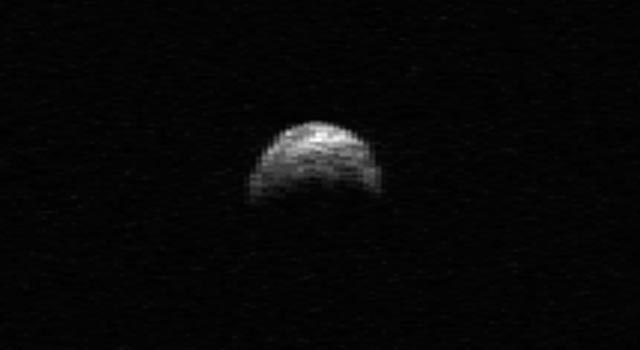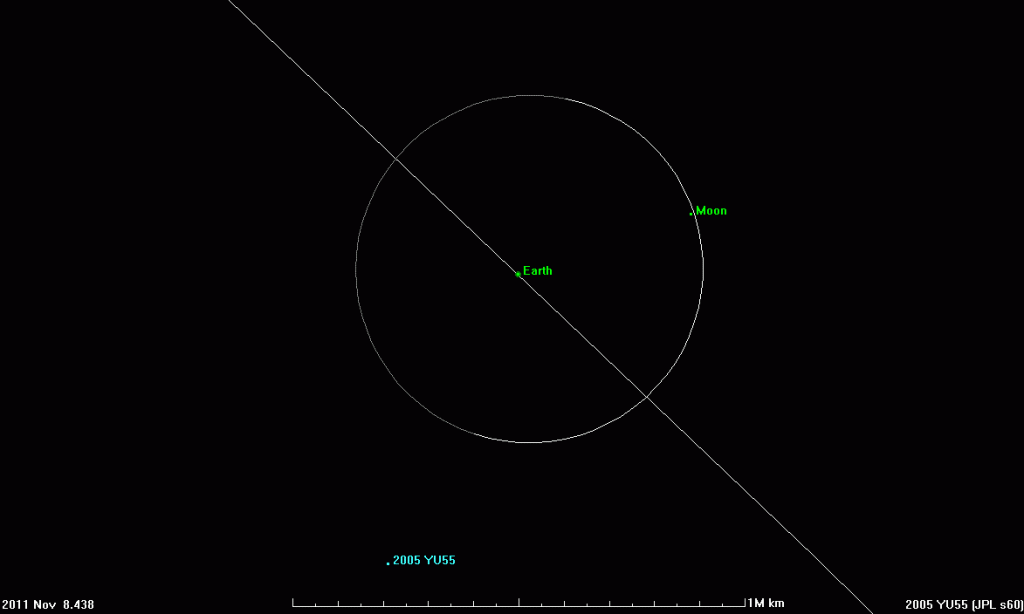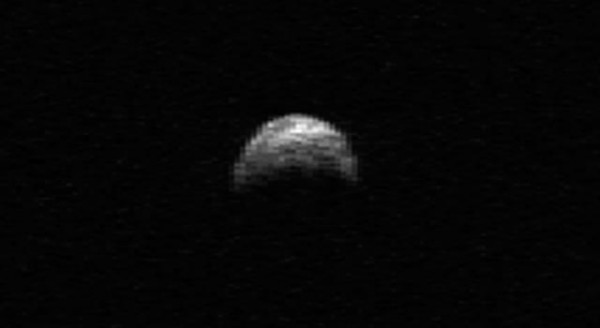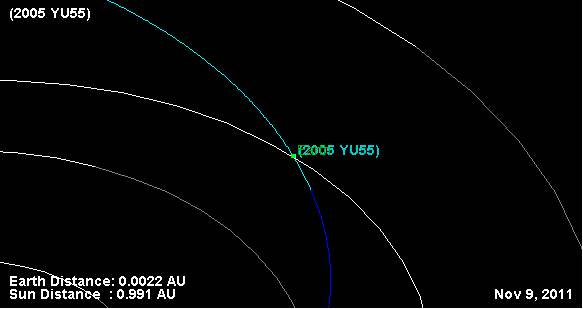Asteroid 2005 YU55 facts & figures

Ok, people. We survived flyby of most popular "doomsday" Comet Elenin, now we facing another potential threat. Scientists assure us that we have nothing to worry about. Asteroid 2005 YU55 is the third close fly-by of a large asteroid to the Earth this year. Anyhow, here we collected some facts and figures released by now by various institutes, research labs and observatories.
NOTE: This page will update daily so make sure to come back for new informations as the space rock comes closer
This giant asteroid called YU55 found by Robert McMillan, head of the Nasa-funded Spacewatch Program at the University of Arizona, Tucson since December 2005. It orbits the sun once every 14 year but it is not close to the Earth for at least a decade.
First, it is important that we define measure units for better understanding:
1 AU = ~150 million kilometers
1 LD = Lunar Distance = ~384,000 kilometer
- Asteroids come within the moon’s distance every so often, but 2005 YU55 is the biggest known asteroid to do so for about the next 17 years. Officially, the asteroid poses no immediate threat to Earth.
- Its orbit is allegedly well known to astronomers – scientist assume that we can rule out an impact for at least the next century.
- According to informations released by NASA's Jet Propulsion Lab / Near Earth Object Program asteroid 2005 YU55 is classified as Apollo which means that it has orbit which cross the Earth's orbit similar to that of 1862 Apollo (a > 1.0 AU; q < 1.017 AU).
- The trajectory of asteroid 2005 YU55 is well understood. At the point of closest approach, it will be no closer than 201,700 miles (324,600 kilometers) or 0.85LD – the distance from the moon to Earth.
- The gravitational influence of the asteroid will have no detectable effect on anything here on Earth, including our planet's tides or tectonic plates. Although 2005 YU55 is in an orbit that regularly brings it to the vicinity of Earth (and Venus and Mars), the 2011 encounter with Earth is the closest this space rock has come for at least the last 200 years.
Orbital and Physical Characteristics

Here you can take a look at physical parameter table:
| Parameter | Symbol | Value | Units | Sigma | Reference | Notes |
| absolute magnitude | H | 21.929 | mag | .46342 | 62 | autocmod 2.5a |
| diameter | diameter | 0.4 | km | n/a | 2010 radar result | http://echo.jpl.nasa.gov/asteroids/2005YU55/2005YU55_planning.html |
| rotation period | rot_per | 18 | h | n/a | 2010 radar result | http://echo.jpl.nasa.gov/asteroids/2005YU55/2005YU55_planning.html |
It said that the asteroid is 400 meters in diameter with lightness magnitude of 22. It is slowly spinning, with a rotation period of about 18 hours.
OBSERVING 2005 YU55
The closest approach occurs just before the date boundary between Nov. 8-9, when 2005 YU55 will move up to 8.6 degrees during the hour between Nov. 8 23:00 – Nov. 9 00:00 UTC. To place that in perspective, the angular width of the Moon is about 0.5 degrees, so YU55 will move 17 lunar diameters per hour or about 0.3 lunar diameters per minute. Motion this rapid will easily be observable in small telescopes with apertures of roughly 15 cm and larger (at this time the asteroid should reach 11th or 12 magnitude). 2005 YU55 will approach Earth from the direction of the Sun, so it won't be visible at night until November 8. Afterward, it will move directly away from Earth, approximately 180 degrees from its approach trajectory. Radar observations provide their own illumination, so both Goldstone and Arecibo will be able to observe the asteroid during the day prior to Nov. 9.
But given that this is close in astronomical terms, astronomers will be observing it carefully. Amateur astronomers who want to get a glimpse at YU55 will need a telescope with an aperture of 6 inches (15 centimeters) or larger. 320,000 km is 3/4 of the way to the Moon, and this asteroid is small and very dark. Observing it will be tough, but you can get more info on how to do it at the Minor Planet site and on The Minor Planet Bulletin.
During the close flyby, scientists will use the massive 70-meter Deep Space Network antenna to study the asteroid. The 70-meter (230-foot) diameter antenna is the largest, and therefore most sensitive, DSN antenna, and is capabile of tracking a spacecraft travelling more than 16 billion kilometers (10 billion miles) from Earth.
A live broadcast and chat from NASA’s Jet Propulsion Laboratory, Pasadena, Calif., will allow viewers to ask questions of scientists with NASA’s Near-Earth Object Program Office about asteroid YU55, and find out how NASA discovers, tracks and characterizes asteroids and comets.
Tracking of the aircraft carrier-sized asteroid will begin at 9:30 a.m. local time (PDT) on Nov. 4, using the massive 70-meter (230-foot) Deep Space Network antenna, and last for about two hours. The asteroid will continue to be tracked by Goldstone for at least four hours each day from Nov. 6 through Nov. 10. Radar observations from the Arecibo Planetary Radar Facility in Puerto Rico will begin on Nov. 8, the same day the asteroid will make its closest approach to Earth at 3:28 p.m. PST.
During tracking, scientists will use the Goldstone and Arecibo antennas to bounce radio waves off the space rock. Radar echoes returned from 2005 YU55 will be collected and analyzed. NASA scientists hope to obtain images of the asteroid from Goldstone as fine as about 7 feet (2 meters) per pixel. This should reveal a wealth of detail about the asteroid’s surface features, shape, dimensions and other physical properties.
NASA conference about asteroid 2005 YU55 close flyby + Live stream!
Major exercises scheduled on November 9 – The day of close approach of asteroid 2005 YU55
NASA detects, tracks and characterizes asteroids and comets passing close to Earth using both ground- and space-based telescopes. The Near-Earth Object Observations Program, commonly called "Spaceguard," discovers these objects, characterizes a subset of them, and plots their orbits to determine if any could be potentially hazardous to our planet.
Asteroid Radar Research (ECHO)
JPL Small-Body Database Browser (2005 YU55)
Other close approaches around Nov 8 2011
Here are some close approaches of NEO's released by NASA's Near Earth Object Program few days before and after YU55 flyby:
| UPCOMING CLOSE APPROACHES TO EARTH |
|
1 AU = ~150 million kilometers |
| Object Name |
Close Approach Date |
Miss Distance (AU) |
Miss Distance (LD) |
Estimated Diameter* |
H (mag) |
Relative Velocity (km/s) |
| (2011 UD) | 2011-Nov-06 | 0.1367 | 53.2 | 200 m – 460 m | 20.6 | 22.44 |
| (2009 VN1) | 2011-Nov-06 | 0.1299 | 50.5 | 39 m – 88 m | 24.2 | 13.61 |
| (2011 UB131) | 2011-Nov-06 | 0.1683 | 65.5 | 120 m – 270 m | 21.7 | 21.75 |
| (2011 UF10) | 2011-Nov-07 | 0.1255 | 48.8 | 55 m – 120 m | 23.4 | 6.16 |
| (2011 FZ2) | 2011-Nov-07 | 0.1949 | 75.9 | 1.0 km – 2.3 km | 17.0 | 24.09 |
| (2007 VF189) | 2011-Nov-07 | 0.1217 | 47.4 | 5.7 m – 13 m | 28.3 | 14.99 |
| (2006 JY26) | 2011-Nov-08 | 0.1208 | 47.0 | 5.7 m – 13 m | 28.3 | 6.58 |
| (2010 LM68) | 2011-Nov-08 | 0.1861 | 72.4 | 180 m – 410 m | 20.8 | 9.55 |
| (2005 XB1) | 2011-Nov-08 | 0.0742 | 28.9 | 120 m – 260 m | 21.8 | 13.15 |
| (2005 YU55) | 2011-Nov-08 | 0.0022 | 0.8 | 400 m | 21.9 | 13.72 |
| (2004 VB61) | 2011-Nov-09 | 0.1866 | 72.6 | 100 m – 230 m | 22.0 | 6.28 |
| (2011 VB) | 2011-Nov-10 | 0.0557 | 21.7 | 27 m – 61 m | 24.9 | 7.21 |
| (2011 TP6) | 2011-Nov-10 | 0.0456 | 17.7 | 21 m – 48 m | 25.5 | 2.81 |
| (2008 UX) | 2011-Nov-10 | 0.1463 | 56.9 | 190 m – 420 m | 20.7 | 18.71 |
| (2011 UA276) | 2011-Nov-10 | 0.0936 | 36.4 | 27 m – 60 m | 25.0 | 6.42 |



Commenting rules and guidelines
We value the thoughts and opinions of our readers and welcome healthy discussions on our website. In order to maintain a respectful and positive community, we ask that all commenters follow these rules:
We reserve the right to remove any comments that violate these rules. By commenting on our website, you agree to abide by these guidelines. Thank you for helping to create a positive and welcoming environment for all.